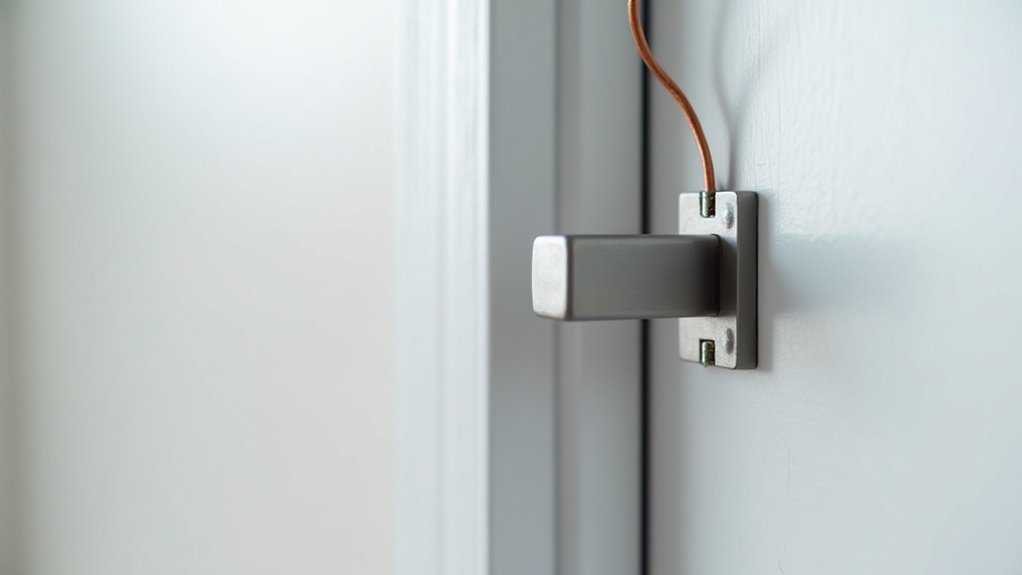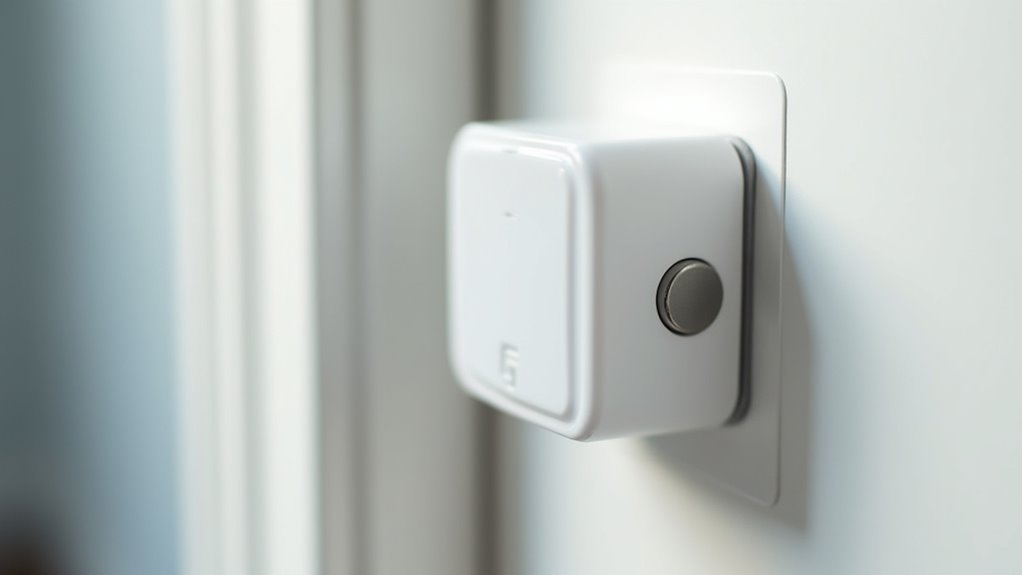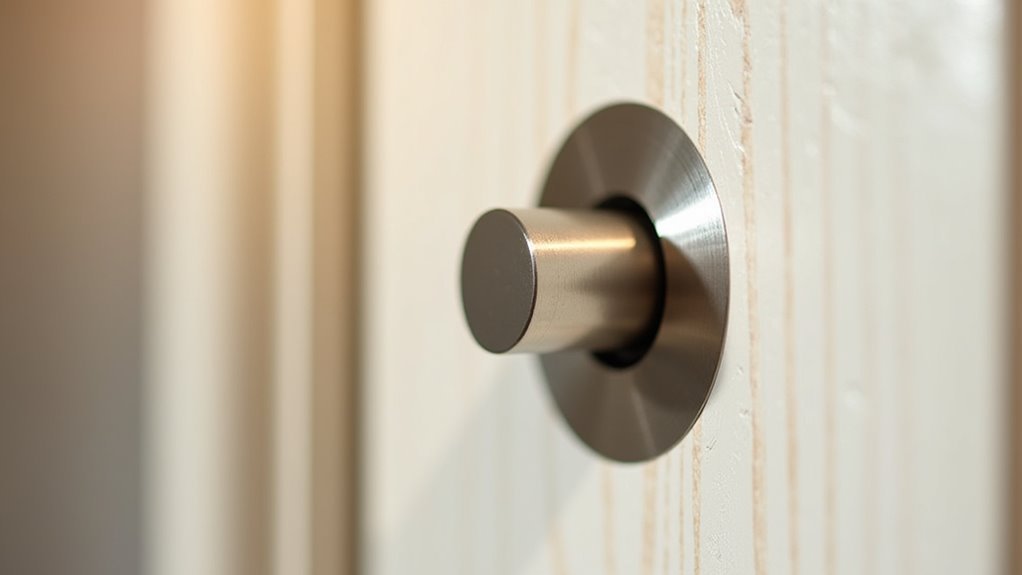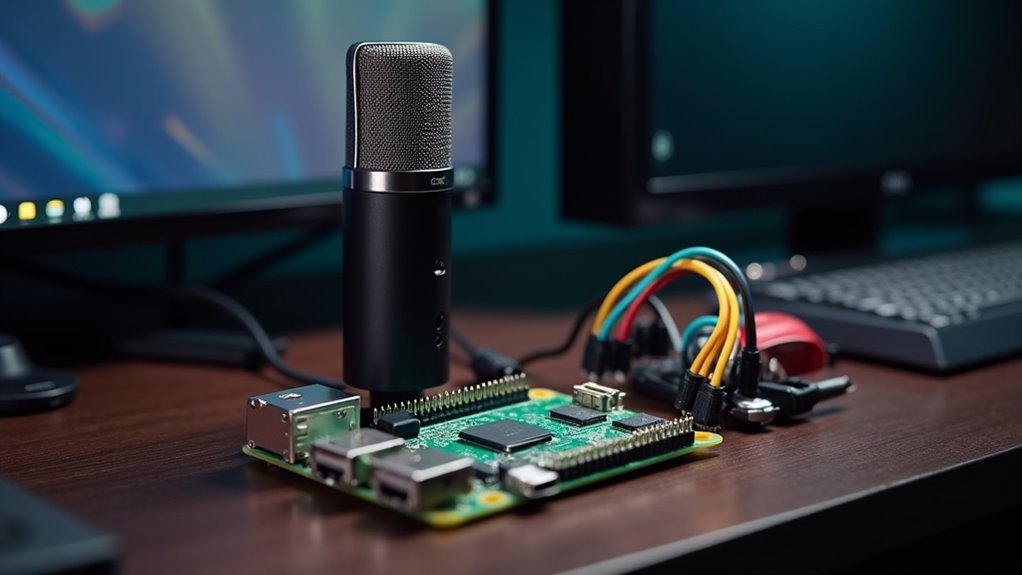You’ve probably noticed those small, unassuming devices mounted on door frames throughout homes and businesses, but you might not realize how essential they are to modern security systems. Door sensors represent one of the most fundamental yet sophisticated components in today’s protection networks, working silently behind the scenes to monitor every entry point. Understanding their inner workings reveals why they’re considered the first line of defense against unauthorized access.
Understanding Door Sensor Technology and Components

When you examine a door sensor system, you’ll find it operates through a surprisingly simple yet effective two-part mechanism.
Door sensors, also known as contact sensors, consist of two essential components that work in tandem to monitor your door’s status.
The first component is a magnetic piece that you’ll attach directly to your door. The second is the sensor body, which you’ll mount on the door frame. These components create a closed electrical circuit when positioned correctly.
The magic happens through a reed switch inside the sensor body. When your door closes, the magnetic field from the magnetic piece activates this switch, allowing current to flow.
Opening the door breaks this magnetic field connection, interrupting the circuit and immediately triggering your security system’s alert.
Magnetic Contact Sensors and Reed Switch Operations
Although the basic principle seems straightforward, the precision engineering behind magnetic contact sensors reveals fascinating details about how these security devices maintain reliable protection.
Precision engineering transforms simple magnetic principles into sophisticated security technology that reliably protects homes for years.
You’ll find these sensors operate through a reed switch paired with a powerful magnet. When you close your door or window, the magnet positions near the reed switch, completing an electrical circuit. Opening the entry point separates these components, breaking the circuit and instantly triggering your home security system’s alert.
You’ll need to install one component on your door or window and the other on the frame, maintaining minimal gap distance.
These reliable devices typically last around ten years, though you’ll replace batteries every one to five years for peak performance in your security setup.
Traditional Surface-Mount Door Sensors

You’ll notice traditional surface-mount door sensors are designed for visible installation, with both the magnetic piece and sensor body clearly mounted on your door and frame surfaces.
These sensors use strong adhesive backing that makes mounting straightforward, but you’re limited to indoor applications since the adhesive and components aren’t weatherproofed for outdoor conditions.
The visible mounting approach means you can easily install and maintain these sensors, though they won’t blend seamlessly into your home’s aesthetic like concealed alternatives.
Visible Installation Method
Since most homeowners prefer straightforward installation without extensive modifications to their doors or frames, traditional surface-mount door sensors offer the most accessible entry point into door security monitoring.
This visible installation method involves mounting the magnetic piece directly onto your door and positioning the sensor body on your door frame using strong adhesive.
You’ll need to guarantee the components remain within 0.4 inches of each other for proper circuit function.
While these door sensors are easily noticeable once installed, they provide reliable monitoring capabilities for your security systems.
The visible placement also allows you to quickly verify sensor positioning and troubleshoot any connectivity issues that may arise during operation.
Adhesive Mounting Process
Installing traditional surface-mount door sensors requires only the strong adhesive backing that comes pre-applied to each component.
You’ll attach the magnetic piece to your door and the sensor body to the door frame without needing any tools. The adhesive mounting system guarantees quick setup while maintaining durability for long-term monitoring.
During the installation process, you must position both components correctly to maintain proper alignment.
The gap between the sensor and magnetic piece shouldn’t exceed 0.4 inches when your door’s closed. This precise spacing guarantees the circuit remains functional for accurate detection.
The adhesive used in door sensors is specifically engineered for permanent mounting, keeping both pieces securely in place throughout continuous door operations and environmental changes.
Indoor Use Limitations
While traditional surface-mount door sensors offer convenient installation, they’re specifically engineered for indoor environments and can’t withstand outdoor weather conditions.
You’ll find these security devices lack the weatherproofing necessary for exterior doors, gates, or sheds where moisture, temperature fluctuations, and UV exposure can damage their components.
Beyond weather limitations, you’ll notice these door sensors remain visible on your door frame, which can compromise your home’s aesthetic appeal.
The exposed design makes them obvious to potential intruders who might attempt to disable them.
For indoor use, you’ll need to maintain precise alignment between the sensor and magnet for reliable operation.
While they’re cost-effective at around $27.50, you’ll want to weigh recessed or outdoor-rated alternatives for enhanced security and weather resistance.
Recessed Door Sensors for Hidden Installation

When you’re seeking a security solution that doesn’t compromise your home’s aesthetic appeal, recessed door sensors offer the perfect balance of functionality and discretion. These sensors install directly into your door and frame through drilled cavities, making them virtually invisible once positioned.
| Feature | Details |
|---|---|
| Average Cost | $35.50 |
| Installation | Requires drilling into door/frame |
| Operation | Reed switch and magnet mechanism |
| Appearance | Seamlessly blends with surfaces |
You’ll find recessed door sensors from select brands like Vivint and Frontpoint. They operate using the same reliable magnet mechanism as traditional sensors—the circuit closes when your door shuts and opens when it’s opened. While installation demands more effort than surface-mounted alternatives, you’ll appreciate how they maintain your home’s clean lines without sacrificing security effectiveness.
Outdoor Weather-Resistant Door Sensors
Unlike their indoor counterparts that prioritize discretion, outdoor weather-resistant door sensors tackle the demanding challenge of protecting exterior entry points like gates, sheds, and patio doors.
These specialized outdoor door sensors feature robust housing that withstands rain, snow, and extreme temperatures while maintaining reliable performance for your security alarm system.
You’ll notice they’re more visible on doors and frames, but this design choice facilitates easier installation and monitoring.
The enhanced sensitivity compensates for outdoor environmental factors that might interfere with detection. While brands like Ring Alarm offer outdoor models, availability remains limited compared to indoor versions.
Expect to invest around $60.50 per sensor, reflecting their specialized engineering.
This investment guarantees your home automation security extends seamlessly to all exterior access points.
Garage Tilt Sensors for Overhead Doors
Garage tilt sensors offer a specialized solution for monitoring overhead garage doors through their unique tilt-detection mechanism.
These sensors detect your garage door’s position by measuring tilt angles, providing reliable security monitoring for one of your home’s largest entry points.
You’ll find these sensors feature weather-resistant designs that withstand outdoor conditions year-round.
Their visible construction makes monitoring straightforward while maintaining durability against temperature fluctuations.
Installation typically costs around $33 from brands like Vivint and Frontpoint.
You can easily mount them using adhesive, but proper alignment is essential to prevent false alarms.
The straightforward installation process makes them accessible for most homeowners.
Motion Detection Door Sensors
Motion detection door sensors use infrared technology to sense heat signatures and movement within their coverage area, typically extending up to 25 feet from the device.
You’ll find these sensors can detect unauthorized activity even when doors and windows remain securely closed, unlike traditional magnetic contact sensors.
Understanding how they determine legitimate movement from potential threats is essential for preventing false alarms that can undermine your security system’s effectiveness.
Infrared Technology Basics
The foundation of motion detection door sensors lies in infrared technology, which detects heat signatures and movement changes within a designated area. Your sensor emits infrared light and measures reflections from objects within its field of view, typically covering up to 30 feet.
When you or someone else moves through this zone, the reflected light pattern changes, triggering the sensor’s alert system.
The technology’s sophistication allows it to distinguish between human movement and background environmental changes. This capability greatly reduces false alarms that pets or shifting objects might otherwise cause.
You’ll find most sensors include adjustable sensitivity settings, letting you customize responsiveness based on your specific needs.
This infrared technology forms the core foundation that makes motion detection reliable and effective for security applications.
Movement Detection Range
Understanding how infrared technology operates naturally leads to examining how far these sensors can effectively monitor your space. Motion sensors typically offer a movement detection range between 15 to 30 feet, depending on your specific model. Most sensors use a 120-degree field of view, creating thorough coverage for doorway monitoring.
| Sensor Type | Detection Range | Field of View | Coverage Area | Typical Use |
|---|---|---|---|---|
| Basic PIR | 15-20 feet | 90-110 degrees | Small rooms | Interior doors |
| Standard Motion | 20-25 feet | 110-120 degrees | Medium spaces | Main entrances |
| Advanced PIR | 25-30 feet | 120+ degrees | Large areas | Commercial doors |
| Outdoor Motion | 30+ feet | 180 degrees | Wide coverage | Exterior monitoring |
| Adjustable Range | 10-30 feet | Variable | Custom zones | Specialized applications |
Your sensor’s effectiveness depends on proper positioning and environmental conditions.
False Alarm Prevention
While motion detection door sensors excel at identifying genuine security threats, false alarms can quickly undermine your confidence in the system and create unnecessary stress.
Fortunately, modern sensors incorporate several features to minimize unwanted alerts and maintain your alarm system’s reliability.
You can prevent false alarms through these essential strategies:
- Adjust sensitivity levels – Customize your sensors to ignore non-threatening movements like curtains swaying or small objects.
- Utilize pet-immune features – Configure settings to prevent alerts from animals under specific weight limits.
- Position sensors properly – Strategic placement away from heat sources and high-traffic areas reduces erroneous triggers.
- Perform regular maintenance – Clean sensors and check battery levels to guarantee peak performance.
Advanced sensors with smart technology integration provide real-time notifications, allowing you to verify threats instantly and further reduce false alarms.
Glass Break Detection Technology
Beyond traditional door and window sensors, glass break detection technology adds a crucial layer to your home security system by monitoring the distinct acoustic signature of shattering glass. These specialized microphones can detect breaking glass from 20-25 feet away, instantly triggering your security system when potential intrusions occur.
| Feature | Capability | Benefit |
|---|---|---|
| Detection Range | 20-25 feet | Wide coverage area |
| Sound Differentiation | Filters non-glass noises | Reduces false alarms |
| Installation | Wireless technology | Easy integration |
| Placement | Near large windows/doors | Strategic protection |
| Response | Instant alarm activation | Immediate notification |
You’ll find these sensors particularly important for protecting areas with large windows or glass doors. Modern wireless models integrate seamlessly with existing systems, differentiating between actual glass break sounds and other loud noises to minimize false alarms.
Wireless Vs Wired Door Sensor Systems
Two distinct technologies dominate door sensor installations: wireless systems that communicate through radio frequencies and wired systems that connect directly through physical cables.
Your choice between wireless door sensor systems and wired door sensor systems depends on your specific needs and installation circumstances.
Here’s what you should consider:
- Installation complexity – Wireless systems offer easy setup without extensive wiring, while wired systems require physical cable connections.
- Reliability – Wired door sensor systems provide more stable connections with minimal signal interference.
- Maintenance – Wireless sensors need battery replacements every 1-5 years, while wired systems eliminate battery concerns.
- Cost factors – Wireless sensors range $20-$50, while wired system costs vary based on installation requirements.
Most security company professionals recommend wireless for renters and wired for permanent installations.
Door Sensor Installation Process and Requirements
Once you’ve selected your door sensor system, proper installation becomes the determining factor in your security setup’s effectiveness. Door sensor installation involves positioning two main components: the sensor body on your door frame and the magnetic piece on the door itself. You’ll need to maintain a maximum gap of 0.4 inches between these components for ideal magnetic field integrity.
| Installation Aspect | Traditional Sensors | Recessed Sensors |
|---|---|---|
| Mounting Method | Strong adhesive | Drilling required |
| Placement | Surface-mounted | Cavity installation |
| Tools Needed | Cleaning supplies | Drill, bits |
| Difficulty Level | Easy | Moderate |
| Orientation Options | Horizontal/Vertical | Horizontal/Vertical |
Always follow manufacturer’s installation instructions to guarantee proper alignment and reliable performance of your security system.
Proper Sensor Alignment and Spacing Guidelines
You’ll need to position your door sensor components within 0.4 inches of each other to guarantee the magnetic circuit functions properly.
Mount the sensor body on your door frame and attach the magnetic piece to the door itself, keeping both elements level and straight during installation.
Any gap exceeding this recommended spacing will prevent the circuit from closing and cause your security system to malfunction.
Optimal Distance Requirements
When installing door sensors, precise positioning determines whether your security system functions reliably or fails during critical moments. You’ll need to maintain strict spacing requirements between the magnetic piece and sensor body to guarantee proper circuit interaction.
Sensor alignment directly affects your system’s ability to detect unauthorized entry attempts.
Follow these distance specifications for ideal performance:
- Position components no more than 0.4 inches (10 mm) apart
- Keep both sensor and magnet perfectly level during installation
- Ascertain straight alignment to prevent circuit closure failures
- Drill precise recessed cavities for snug component fitting
Misaligned sensors won’t close the circuit properly, causing detection failures when doors open.
Regular spacing checks help maintain functionality and extend your sensors’ lifespan, preventing costly false alarms.
Alignment Best Practices
Most door sensor failures stem from improper alignment during installation, making precise positioning your most critical task.
You’ll need to maintain a maximum 0.4-inch gap between the magnetic piece and sensor body for effective interaction. Mount the sensor body on your door frame and attach the magnetic piece to the door itself, positioning them as close together as possible when closed.
For recessed sensors, drill accurately to prevent uneven surfaces that compromise functionality. Keep your drill level and straight throughout installation to achieve ideal alignment.
Any misalignment or incorrect spacing prevents proper circuit interaction, causing malfunctioning alerts or alarms. Double-check your measurements before drilling, as precise alignment guarantees reliable sensor performance and eliminates false triggers.
Integration With Home Security and Automation Systems
While door sensors function effectively as standalone devices, their true potential emerges through integration with extensive home security and automation systems.
Door sensors reach their full potential when integrated with comprehensive home security and automation systems rather than operating alone.
You’ll find that door sensors seamlessly connect with home security systems, allowing you to control alarms through keypads when entering or leaving. Smart technology enhances these capabilities considerably.
Here’s how integration benefits you:
- Real-time notifications – Wireless connectivity sends instant alerts to your smartphone, keeping you informed of door activity regardless of system status.
- Customizable settings – Adjust sensitivity levels to prevent false alarms from pets or minor movements.
- Home automation compatibility – Monitor door status and receive updates on smart devices.
- Coordinated responses – Advanced programming synchronizes alerts across your entire security system for thorough protection.
Battery Life and Maintenance Requirements
Although door sensors operate with remarkable reliability, their effectiveness depends entirely on proper battery maintenance and regular upkeep. You’ll need to monitor battery life, which typically ranges from one to five years depending on usage frequency and sensor type.
| Maintenance Task | Frequency |
|---|---|
| Battery status check | Monthly |
| Sensor alignment inspection | Quarterly |
| Communication test | Quarterly |
| Battery replacement | 1-5 years |
| Maintenance log update | After each check |
Regular maintenance guarantees your sensors remain properly aligned and communicate effectively with your security system. You should immediately report malfunctioning sensors to your security provider for troubleshooting. Keeping a detailed maintenance log helps you track battery replacements and inspections, ensuring peak performance and preventing unexpected failures that could compromise your home’s security.
Troubleshooting Common Door Sensor Issues
When your door sensor starts acting up, you’ll likely face two main problems that can disrupt your security system’s reliability.
False alarms often stem from misalignment between the sensor and magnet, interference from nearby electronics, or environmental factors affecting the device’s performance.
You’ll also encounter battery-related issues that require regular replacement every 1-5 years, and if you ignore low battery warnings, your sensor won’t respond when you need it most.
False Alarm Prevention
Since door sensors can trigger false alarms that undermine your security system’s effectiveness, understanding common issues and prevention methods is essential for maintaining reliable protection.
To prevent false alarms and guarantee your sensors work at peak performance:
- Check installation gaps – Maintain less than 0.4 inches between sensors and magnets to preserve the magnetic field integrity.
- Schedule regular maintenance – Replace batteries every 1-5 years and inspect sensors for wear or damage.
- Adjust sensitivity settings – Fine-tune detection levels to avoid triggering from pets or minor vibrations.
- Consider environmental factors – Install sensors away from extreme weather exposure and electrical interference sources.
When false alarms persist despite these measures, contact your security provider for professional troubleshooting.
They’ll help recalibrate sensors or recommend alternatives that better suit your environment, guaranteeing your security cameras and alarm system work together effectively.
Battery Replacement Issues
Battery-related problems account for roughly 80% of door sensor malfunctions, making them your first troubleshooting target when sensors stop responding or trigger inconsistent alerts.
When your door sensor fails to operate properly, check the battery immediately since low power directly affects performance and reliability.
Most door sensors provide low battery notifications, allowing you to replace batteries proactively before complete failure occurs.
Always use manufacturer-recommended battery types to prevent compatibility issues that could cause additional malfunctions.
Battery replacement should occur every one to five years depending on usage patterns and sensor specifications.
Regular battery maintenance guarantees consistent functionality within your security system.
Don’t wait for complete sensor failure—monitor battery levels regularly and replace them at the first sign of declining performance to maintain peak protection.
Frequently Asked Questions
What Triggers Door Sensors?
You’ll trigger door sensors when you break the magnetic contact between the sensor and magnet by opening doors. Unauthorized entry attempts, strong winds moving doors, or low battery malfunctions can also activate them.
Do Door Sensors Work Without Wifi?
Yes, you’ll find that basic door sensors work without Wi-Fi since they operate on closed circuits. However, you’ll need Wi-Fi for smart features like remote notifications and smartphone app control.
How Does a Door Handle Sensor Work?
Your door handle sensor uses a magnetic switch that detects when you turn the handle. When you engage the handle, it triggers the sensor, which can send alerts to your security system or smartphone.
How Can You Tell if a Door Sensor Is Bad?
You’ll notice a bad door sensor when it doesn’t trigger alarms upon opening, shows physical damage like cracks, has a dead battery, or its LED indicator doesn’t light up properly.





Leave a Reply